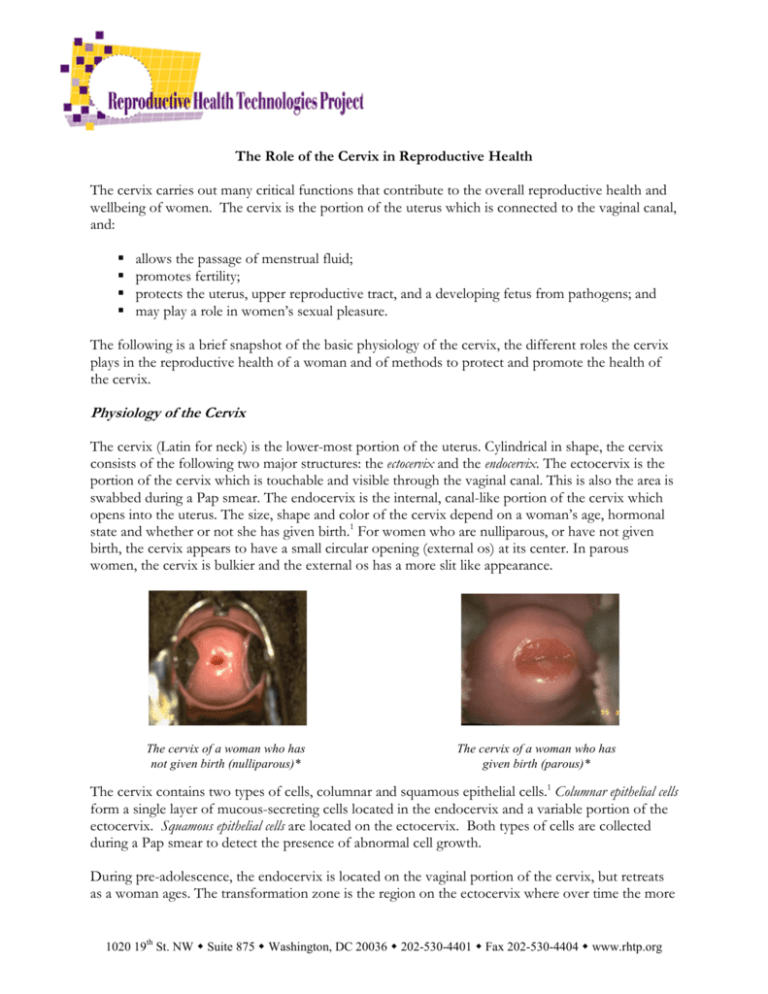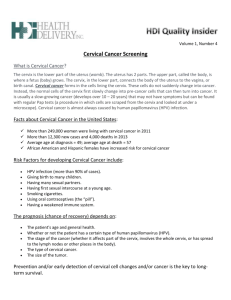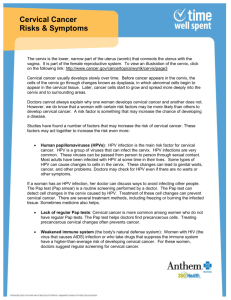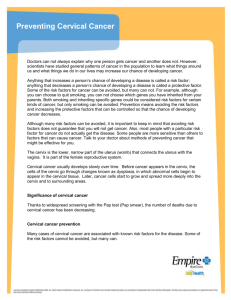Physiology of the Cervix - Reproductive Health Technologies Project
advertisement

The Role of the Cervix in Reproductive Health The cervix carries out many critical functions that contribute to the overall reproductive health and wellbeing of women. The cervix is the portion of the uterus which is connected to the vaginal canal, and: allows the passage of menstrual fluid; promotes fertility; protects the uterus, upper reproductive tract, and a developing fetus from pathogens; and may play a role in women’s sexual pleasure. The following is a brief snapshot of the basic physiology of the cervix, the different roles the cervix plays in the reproductive health of a woman and of methods to protect and promote the health of the cervix. Physiology of the Cervix The cervix (Latin for neck) is the lower-most portion of the uterus. Cylindrical in shape, the cervix consists of the following two major structures: the ectocervix and the endocervix. The ectocervix is the portion of the cervix which is touchable and visible through the vaginal canal. This is also the area is swabbed during a Pap smear. The endocervix is the internal, canal-like portion of the cervix which opens into the uterus. The size, shape and color of the cervix depend on a woman’s age, hormonal state and whether or not she has given birth.1 For women who are nulliparous, or have not given birth, the cervix appears to have a small circular opening (external os) at its center. In parous women, the cervix is bulkier and the external os has a more slit like appearance. The cervix of a woman who has not given birth (nulliparous)* The cervix of a woman who has given birth (parous)* The cervix contains two types of cells, columnar and squamous epithelial cells.1 Columnar epithelial cells form a single layer of mucous-secreting cells located in the endocervix and a variable portion of the ectocervix. Squamous epithelial cells are located on the ectocervix. Both types of cells are collected during a Pap smear to detect the presence of abnormal cell growth. During pre-adolescence, the endocervix is located on the vaginal portion of the cervix, but retreats as a woman ages. The transformation zone is the region on the ectocervix where over time the more 1020 19th St. NW Suite 875 Washington, DC 20036 202-530-4401 Fax 202-530-4404 www.rhtp.org fragile columnar epithelial cells are replaced with more durable squamous epithelial cells.1,2 This area is particularly vulnerable to pre-cancerous changes (dysplasia) due to the high turnover rate and low maturation level of the cells.1,3 Fertility, Pregnancy and the Cervix Throughout the menstrual cycle, the cervix changes in size, location and texture. Just prior to ovulation, estrogen levels rise causing the cervix to swell and soften and the external os to dilate, allowing sperm better access to the uterus.4 Also during this time, the cervix secretes slippery, clear and stretchy mucus which exudes from the cervix into the vagina. This ‘fertile mucus’ facilitates the ability of sperm to travel from the vagina into the uterus and can help keep sperm alive for up to five days. After ovulation, progesterone causes the cervix to harden, close, and secrete thicker, cloudy, (or opaque) mucus which acts as a plug, preventing bacteria and sperm from entering the uterus. Further, when this thick mucus is present, fertilization is very unlikely. Women who wish to become pregnant may track the changes in their cervical mucus to determine when intercourse is most likely to result in fertilization. 4 Alternatively, women who wish to prevent pregnancy may utilize the changes in mucus to determine the days during their cycle on which they should abstain or use a barrier method to prevent pregnancy. When a woman becomes pregnant, the hormone progestin will create more of the thick mucus which acts as a plug and prevents any bacteria or pathogens from entering the uterus, thus protecting the health of the developing fetus. A firm, closed cervix also holds the developing fetus in the uterus until it reaches full term. In cases where labor is induced, the cervix must be softened prior to the actual initiation of labor. If this is not done, cesarean delivery is more likely as well as potentially serious complications for the woman. The Cervix and Sexual Pleasure There is still a great deal yet to understand about the physiology of female sexual response and the different roles nerve endings in the vaginal canal and the cervix play in sexual response. Some research on hysterectomy patients supports a relationship between the cervix and sexual pleasure. Some argue that the nerve endings surrounding the cervix can result in a cervical orgasm. This, along with many other factors including, but not limited to, a decreased risk of surgical complications, urinary and sexual dysfunction, has caused a renewed interest in supracervical hysterectomy (removal of the uterus, leaving the ovaries and cervix intact).5 However, the research to date on this issue has been inconclusive. The Cervix and Disease The primary cause of cervical infection or disease is acquisition of a sexually transmitted infection (STI). Certain biological and structural factors render different portions of the cervix more or less susceptible to certain STIs than others. For example, the columnar epithelial cells located in the endocervix and portions of the ectocervix appear to be vulnerable to chlamydia and gonorrhea.3 Additionally, a growing body of research suggests that the cervix is the primary site of HIV infection for women.6 Page 2 of 7 Perhaps the STI with the most impact on the cervix is the human papillomavirus (HPV). HPV is the most common sexually transmitted viral infection in the US. It is estimated that 75% of the adult female and male population has at one point in time been exposed to HPV. 7 In many cases, an HPV infection will heal on its own, and an infected woman may not have any future adverse effects on her cervix. If HPV persists over time, however, pre-cancerous cells may develop. If these pre-cancerous, or dysplastic, cells are not detected and treated they can progress to cancerous cells in the cervix. Nearly 100% of cervical cancer cases arise from previous exposure to specific strains of HPV. 7 Over 100 types of HPV have been identified, though only a few strains have been found to be associated with the presence of pre-cancerous and cancerous cells. The American Cancer Society estimates that in 2009 approximately 11,270 cases of cervical cancer will be diagnosed in the US and approximately 4,070 women will die from the disease.8 According to the National Cervical Cancer Coalition, women in developing countries account for about 85% of both the annual worldwide cases of cervical cancer (estimated at 473,000) and the annual worldwide deaths from cervical cancer (estimated at 253,500).9 A parous cervix with pre-cancerous changes noted by the white area around the cervical os* Most cases of cervical cancer occur in women older than 35; cervical cancer rarely occurs in women younger than 20.8 Among various US ethnic groups, Hispanic women have the highest incidence rate of cervical cancer followed by African American and Asian American and Pacific Islander women respectively.10 As with other cancers, early detection of both pre-cancerous and cancerous cells has a significant impact on morbidity and mortality rates. The average five year survival rate for early detection without migration to the lymph nodes or other areas is 92%.8 However, access barriers to detection and treatment services have had an adverse impact on the survival rates for women of color, including African American, Hispanic, American Indian, Alaska Native, Asian American and Pacific Islander women.10 Detecting and Preventing Cervical Disease Great strides have been made towards reducing the incidence, morbidity and mortality of cervical cancer. Much of this is due to the introduction of the Pap test (or Pap smear) as a cervical cancer screening tool. Its widespread use has reduced deaths attributed to cervical cancer by 74%.8 However, the Pap test is not 100% effective in detecting the presence of precancerous or cancerous cells. In some instances pap tests results inaccurately show abnormal cell growth when in fact the Page 3 of 7 cervix is healthy; this is termed a false positive. Other times, the Pap test fails to detect abnormal cell growth; which is referred to as a false negative. It is estimated that the false positive rate is approximately 5% and the false negative rate is between 20-30%.11 In instances where the results from a Pap test are inconclusive or abnormal a health care provider may perform a colposcopy, a procedure where a special microscope (colposcope) is used to visually examine the cervix and detect abnormalities. There is an ongoing effort to improve detection mechanisms to reduce the rates of false positive and false negative results. One example is the development of a DNA test for HPV that can detect the 13- high-risk types of HPV which may lead to cervical cancer. In women age 30 years and older, the FDA has approved the use of the HPV test in concurrence with a woman’s annual Pap test. However, in women younger than 30, the test is used only in instances where results from a Pap test are inconclusive.7 Finally, there are two vaccines for preventing the onset of certain strains of HPV infection, Gardasil and Cervarix. Gardasil, developed by Merck, was approved for use in women and girls ages 9-26 in June 2006. Gardasil use was extended to boys and men ages 9-26 in October 2009. Cervarix, developed by GlaxoSmithKline, was approved for use in girls ages 10-25 in October 2009. The price for Gardasil is around $360 and Cervarix, because it was only recently approved, has not yet been priced for the US market. For more information about the vaccines, please see our updated “HPV Vaccine Factsheet” at www.rhtp.org. Promoting Cervical Health In addition to diagnostic testing like Pap smears and HPV DNA tests, there are additional actions women can take to promote the health of their cervix. One of the most effective ways to protect the cervix is to avoid contracting an STI. Currently, condoms, limiting the number of sexual partners and abstinence are the only proven methods for reducing the risk of infection with HIV or STIs. However, women are not always in a position to refrain from sex or negotiate condom use with their partner. This factor, along with the evolving understanding of the relationship between STI infection and the cervix has motivated researchers to examine the ability of other barrier methods – such as diaphragms and cervical caps – to reduce STI/HIV transmission. While preliminary findings from observational studies suggest that these methods may reduce transmission, more research is needed to provide conclusive evidence these benefits exist.2 It is estimated that 27% of American women between the ages 15-44 douche regularly.12 Unfortunately, douching has been linked to increased rates of STIs and upper cervical infections, primarily due to the changes it causes in the chemical balance of the vagina.13 Therefore to maintain a healthy vagina and cervix, health care professionals recommend against douching.13 Self-examination of the cervix provide a unique opportunity for women to learn what their cervix looks like when it is healthy so that in the future they are able to identify early changes or infections. While performing a self-examination should not replace regular visits with a health care provider, it is an important tool for enhancing cervical health. In order to perform a self-examination, a woman needs a speculum (an instrument used to hold the walls of the vagina apart), a mirror, a light source and a lubricant. There are several print and electronic resources for women interested in learning how to perform self-examinations including: Page 4 of 7 Feminist Women’s Health Center Boston Women’s Health Book Collective A final recommendation for promoting cervical health is to regularly undergo cervical screenings (Pap test). Many leading professional organizations including the American College of Obstetricians and Gynecologists (ACOG)14 and the American Cancer Society (ACS)15 have developed guidelines to help promote routine cervical screening among providers and women. They are as follows: Recommendations Age to begin screening* ACOG: Cervical cancer screening should begin at 21 years old ACS: Cervical cancer screening should begin about three years after a woman begins having vaginal intercourse, but no later than 21 years of age Age to discontinue ACOG and ACS recommends It is reasonable to stop cervical screening cancer screening at age 65 or 70 among women who have three or more negative cytology results in a row and no abnormal test results in the past 10 years. Screening periods ACOG: Women 30 and older should be screened for cervical for women under cancer whether by conventional or liquid PAP test once every 2 30* years. ACS: Cervical screening should be done every year with regular Pap tests or every two years using liquid-based Pap tests. Screening periods ACOG and ACS recommend women 30 and older who have had for women over 30 3 consecutive negative tests be screened once every 3 years. However, both groups recommend that certain women, including those with HIV or a weakened immune system, get screened every year. The same goes for women who have had previous cervical abnormalities, and women exposed to the chemical DES. Screening for Women who have had a hysterectomy with removal of the cervix women who have for benign reasons and with no history of abnormal or cancerous had a total cell growth may discontinue routine screening. Women who have hysterectomy had a hysterectomy but have a history of abnormal cell growth may discontinue screening after they have three consecutive, negative tests. * differing guidelines between ACOG and ACS In 1991, the Centers of Disease Control & Prevention established the National Breast and Cervical Cancer Early Detection Program (NBCCEDP), a program which aims to provide low income, uninsured, and underserved women access to screening programs for the early detection of breast and cervical cancers.16 The program is available in all 50 states, 4 US territories, the District of Columbia, and 13 American Indian/Alaska Native organizations. More information regarding free or low-cost cervical cancer screening services through NBCCEDP can be obtained by contacting your local or state health department. Page 5 of 7 Additional Resources on Cervical Health and Wellness American Cancer Society – All About Cervical Cancer www.cancer.org/docroot/CRI/CRI_2x.asp?sitearea=&dt=8 This section of the ACS website provides a comprehensive overview of cervical cancer for patients, family and friends. Included is information regarding the detection, diagnosis and treatment of cervical cancer as well as additional resources. American Social Health Association www.ashastd.org The American Social Health Association is recognized by the public, patients, providers and policy makers for developing and delivering accurate, medically reliable information about STDs. The Centers for Disease Control and Prevention- Cervical Cancer Fact Sheet http://www.cdc.gov/cancer/nbccedp/cc_basic.htm This fact sheet provides information on cervical cancer and screening. Feminist Women’s Health Center www.fwhc.org The Feminist Women's Health Center is a non-profit organization that provides woman-centered healthcare and education. The site contains information on cervical health, self exams and contraceptive methods. Page 6 of 7 Notes 1.American Society for Colposcopy & Cervical Pathology. Practice Management: The Cervix. Available at: http://www.asccp.org/edu/practice/cervix/histology.shtml. 2. Cervical Barriers Advancement Society. Preventing HIV/STIs. Available at: http://www.cervicalbarriers.org/information/preventing.cfm. 3. Cates W Jr. The epidemiology and control of sexually transmitted disease in adolescents. Adolesc Med 1990;1:409-28. 4.Hatcher RA, Trussell J, Stewart F, Nelson AL, Cates W, Guest F, Kowal D. Contraceptive Technology. 18th Edition, 2004 Ardent Media Inc, New York. 5. Saini J, Kuczynski E, Gretz HF, Sills ES. Supracervical Hysterectomy versus total abdominal hysterectomy: perceived effects on sexual function. BMC Women’s Health. 2(1), January 2002. 6. Moench T, Chipato T, Padian N. Preventing disease by protecting the cervix: the unexplored promise of internal vaginal barrier devices. AIDS 2001;15:1595-1602. 7. Association of Reproductive Health Professionals. Cervical Cancer Prevention and HPV DNA Testing. Health & Sexuality. Volume 10(1). January 2005 8. American Cancer Society. Detailed Guide: Cervical Cancer. “What are the Key Statistics About Cervical Cancer?” September 2009. Available at:http://www.cancer.org/docroot/CRI/content/CRI_2_4_1X_What_are_the_key_statistics_for_cervical_cancer_8.as p?sitearea= 9. National Cervical Cancer Coalition. Available at: http://www.nccc-online.org/ 10. Age Adjusted Rates and Trends by Race and Ethnicity. SEER Cancer Statistics Review, 1975-2006. National cancer Institute. Available at: http://seer.cancer.gov/csr/1975_2006/browse_csr.php?section=5&page=sect_05_table.10.html 11. National Cancer Institute: Cervical Cancer Screening: Accuracy of the Pap Test. Available at http://cancer.gov/cancertopics/pdq/screening/cervical/HealthProfessional/page5 12. National Women’s Health Information Center. Douching. November 2002. Available at: http://www.4woman.gov/faq/douching.htm 13. Kirchner JT. Prevalence of Vaginal Douching Despite its Adverse Effects. American Family Physician. February 1st 2000. 14. American College of Obstetricians and Gynecologists. First Cervical Cancer Screening Delayed Until Age 21 Less Frequent Pap Tests Recommended November 20, 2009. Available at: http://www.acog.org/from_home/publications/press_releases/nr11-20-09.cfm 15. American Cancer Society. New Cervical Cancer Early Detection Guidelines Released. February 11th 2002. Available at: http://www.cancer.org/docroot/NWS/content/NWS_1_1x_New_Cervical_Cancer_Early_Detection_Guidelines_Rele ased.asp 16. Centers for Disease Control and Prevention. The National Breast and Cervical Cancer Early Detection Program: Saving Lives Through Screening. Last reviewed May 10, 2005. Available at: http://www.cdc.gov/cancer/nbccedp/about2004.htm *Photos courtesy of JHPIEGO. 2000. Atlas of Visual Inspection of the Cervix with Acetic Acid (VIA). JHPIEGO: Baltimore, MD. Page 7 of 7





